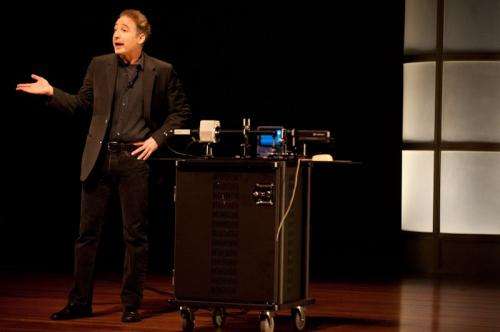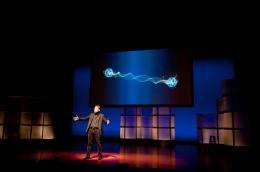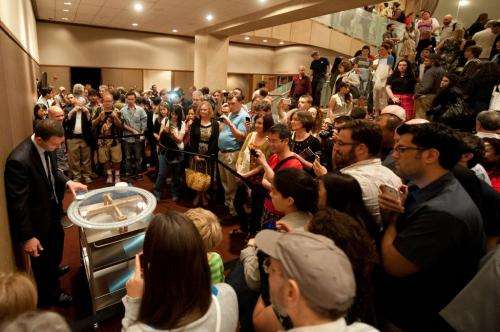August 8, 2012 feature
Sets & the city: World Science Festival 2012, New York style (Part 2 of 2)

(Phys.org) -- New York City is the nexus of all things intellectual, cultural and academic. (Being a native New Yorker, I admit being somewhat biased.) Either way, one highlight in this complex and vibrant metropolis is the annual World Science Festival, founded in 2008. World Science Festival 2012 was a nearly week-long orchestration of myriad events focused on a wide range of topics embracing not just science, but also art, architecture, film, music, and technology.
The Festival was co-founded in 2008 by quantum physicist and string theorist Brian Greene, Columbia University professor of physics and mathematics and bestselling author of The Elegant Universe and The Hidden Reality, and Tracy Day, Emmy Award-winning journalist and television producer. The annual event brings together many of the world’s leading scientific minds with renowned artists and influential thinkers for a five-day celebration that, through discourse and debate, conversation and performance, the arts and exhibitions, allows everyone to experience science in a unique and thrilling way. Since its inception, the Festival has attracted some 600,000 people to over 200 original programs.
A special event held at the NYU Global Center, On the Shoulders of Giants: Evolution and the Battle for Dominance was a talk on the study of human social behavior and evolutionary biology given by Edward O. Wilson, the sometimes controversial entomologist, evolutionary biologist, National Medal of Science recipient, and two-time Pulitzer Prize-winning author. Wilson is the Pellegrino University Research Professor Emeritus and Honorary Curator in Entomology at Harvard University and a founding advisor of the E.O. Wilson Biodiversity Foundation, a non-profit organization a nonprofit organization leveraging education, technology, and business strategies to further the preservation of biodiversity and our biological heritage.

Wilson began with a sweeping but concise account of the main steps from pre-human to human (covering bipedalism, fire’s ability to cook meat that enhanced digestibility, increased brain size, early campsites, an Australopithecine out-of-Africa diaspora, and so on). He then delved into eusociality, his controversial take on sociobiology (itself hotly debated) in which some individuals reduce their own lifetime reproductive potential to raise the offspring of others. Wilson sees eusociality as the natural selection-based altruism he observed in ant colonies that underlies the most advanced forms of social organization and the ecologically dominant role of both social insects and humans.
Later the same day at The New School’s Tishman Auditorium, Wilson appeared as a panelist in Why We Prevailed: Evolution and the Battle for Dominance. With John Hockenberry again the moderator, Wilson and the other panelists – Alison Brooks, professor of anthropology and international affairs at George Washington University and a founding member of the Center for the Advanced Study of Hominid Paleobiology; Ed Green, a genome biologist who found evidence of gene flow from Neanderthals to modern humans; and Chris Stringer, paleoanthropologist – discussed their views on why we survived but our hominid ancestors and relatives became extinct.
Video: Copyright © 2012 World Science Festival
With the panelists’ diverse backgrounds, a wide range of perspectives was to be expected. In addition to many of the points Wilson raised in On the Shoulders of Giants, they discussed climate instability, diet, grain starch, lactose intolerance, differential disease resistance, differences in neurotransmitters, absorption by interbreeding, and other factors that – amazingly – have moved from assumption to fact through the panelists’ research in paleobiology, genome biology, and paleoanthropology.
In the end, the panelists seemed to agree that our species is not one given to co-existence. “Just in terms of population census size, we’re off the rails,” said Green. “This is unprecedented: If you compare current humans with all previous humans and all other great apes alive today, there are 7 billion of us and 100,000 of the most populous great apes. Not only did we crowd out all the other hominid forms; we’re on our way to crowding out all the great apes. Our biggest danger is our success.”
Video: Copyright © 2012 World Science Festival
Brooks pointed out that we even do this to other humans. “I don’t think that we do well at co-existence. When we meet another population of our own species, there ends up being one group that dominates the other. There’s always an asymmetry.”
Stringer reminded us of the impact of climate change. “People have gotten though climate change in the past, but we’re headed into new territory with the predicted rises people are talking about. For example, large areas of the tropics and subtropics could end up being uninhabitable. That could really change our future – it really is a threat.”

One even darker possibility, concluded Wilson, is that our demonstrated aggression will continue. “We’re an extremely aggressive species that displaces our own genotype. As William James said, history is a bloodbath. We should see this as a powerful generating force for what we are.”
History is replete with histrionics – and in Spooky Action: The Drama of Quantum Mechanics, held at the NYU Skirball Center for the Performing Arts, quantum physicist and string theorist Brian Greene and actors Elizabeth Stahlmann, Michael Roush and Raja Burrows blended theory, experiment, history, media, and theater to recreate a window into the drama surrounding Einstein, Bohr and the long debate over whether quantum entanglement was correct or, as Einstein (who actually identified entanglement in a Nobel Prize-winning paper on quantum mechanics) asserted, an error in quantum theory.
Spoiler alert: Einstein was wrong – but his paper was right.
Part 1: phys.org/news/2012-08-city-wor … ival-york-style.html
More information: The evolution of eusociality, Nature 466, 1057–1062 (26 August 2010), doi:10.1038/nature09205
The revolution that wasn't: a new interpretation of the origin of modern human behavior, Journal of Human Evolution, Volume 39, Issue 5, November 2000, Pages 453–563, doi:10.1006/jhev.2000.0435
The Neandertal genome and ancient DNA authenticity, The EMBO Journal (2009) 28, 2494 – 2502, doi:10.1038/emboj.2009.222
Earliest Directly-Dated Human Skull-Cups, PLoS ONE 6(2): e17026 (2011), doi:10.1371/journal.pone.0017026
Journal information: Nature , Journal of Human Evolution , EMBO Journal
Copyright 2012 Phys.org
All rights reserved. This material may not be published, broadcast, rewritten or redistributed in whole or part without the express written permission of PhysOrg.com.
















